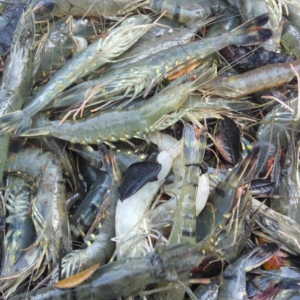
Control Ammonium and Nitrite When Nursing White Shrimp In Bioflocs
| Fri, 09 Apr 2021 - 10:42
Strategy for control of ammonium and nitrite in vannamei culture system using bioflocs.
In biofloc culture systems, nitrogen compounds, especially ammonia and nitrite, must be controlled by microbiological pathways, mainly through heterotrophic and chemotrophic activity.
This study evaluated different strategies for water preparation (heterotrophic, chemotrophic and mature biofloc) for the nursery of vannamei shrimp in the biofloc system and yielded considerable efficacy.
Also read: Biofloc Systems, Tilapia by Product may Support Cheaper Shrimp Production
Research and application of bioflocs technology in white leg shrimp nursery
A 35-day study was performed with postlarvae (0.08 g) stocked in twelve 300L tanks with a stocking density of 2000 kernels / m 3 .
The experiment evaluated postlarvae culture in three different biofloc systems: heterotrophic biofloc, chemotrophic and mature biofloc.
i) Heterotrophic treatment, in which water receives sugar as a carbon source.
ii) Chemical treatment in which ammonium and nitrite salts have been added to the water.
iii) Maturation treatment, which is produced by the addition of a significant amount of maturation biofloc-containing water from another established biofloc system.
Also read: Effects Of Carbohydrate Sources on A Biofloc Shrimp Nursery
Result
Water quality parameters
The heterotrophic treatments had lower DO concentrations than the mature and chemotrophic biofloc treatments.
The heterotrophic system had higher ammonia and nitrite content than the other treatments. Total suspended solids (TSS) were higher in the heterotrophic treatment than in the adult treatment. Total volatile suspended solids (VSS), fixed total suspended solids (FSS) and suspended solids (SS) concentrations were higher in the heterotrophic treatment than in both the chemotrophic and maturation treatments. .
In both the control of biofloc growth and chemotherapy, nitrification can keep toxic nitrogen compounds (ammonia and nitrite) low without the addition of carbohydrates. In contrast, the heterotrophic system showed peaks of ammonia and nitrite during the culture cycle, and the levels of these compounds were higher than those of the rest of the treatments.
Microbiological community
At the beginning of the experiment, the number of heterotrophic bacteria survived was higher in the heterotrophic system than in the maturation and chemotherapy treatments. Similarly, bacteria of the Vibrionaceae family were more likely to be in heterotrophic systems than in mature and chemotrophic treatments at the same time.
The Vibrionaceae family at the beginning of the experiment was lower than the heterotrophic and mature treatment. The combination of low Vibrionaceae count and good water quality resulted in an improvement in growth efficiency in this treatment.
Also read: Evaluating Compensatory Growth in Pacific White Shrimp in a Biofloc System
Growth
Average body weight and growth rates were higher in the chemically treated shrimp than in adults. However, there was no difference (p ≥ 0.05) between heterotrophic treatment and other treatments. The final biomass and yield were higher in both the nutrient and heterotrophic treatments than in the mature treatment. There was no significant difference (p ≥ 0.05) in survival rate and feed conversion ratio among the treatments.
This study demonstrated that different water preparation strategies have a significant impact on biofloc composition, water quality and shrimp performance. During the test, both the vegetative and maturation systems were able to control nitrogen compound levels within acceptable limits for Litopenaeus vannamei , mainly due to the presence of autotrophic nitrifying bacteria from the beginning of the experiment in these systems. Although the metabolic and maturing systems are able to prevent the accumulation of nitrogen compounds are similar, the performance of the shrimp is different in the two systems. Specifically, the growth rate of shrimp in the chemotherapy treatment was 41% higher than that in the mature system
Nitrite accumulation at the midpoint of the experiment in the heterotrophic system indicates that nitrification is taking place in the tanks. Bacteria that convert ammonia to nitrite have a faster growth rate than bacteria that convert nitrite to nitrate, especially in salt water (Madigan et al., 2016). Nitrifying bacteria and consequently nitrification are affected by environmental factors, such as temperature, pH, substrate concentration, inhibitory factors and dissolved oxygen (Cervantes, 2009).
The performance assessment of shrimp showed that the chemotherapy system was a good approach for the management of shrimp nurseries with biofloc. The chemo-treatment was outstanding for its ability to keep water quality at a stable level and contain a lower amount of bacteria from the Vibrionaceae family at the beginning of the cycle.
Source: Tepbac.com






















